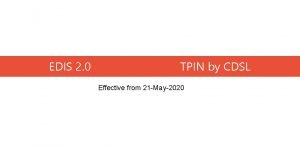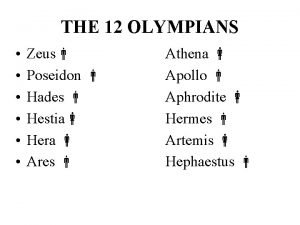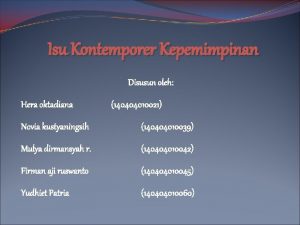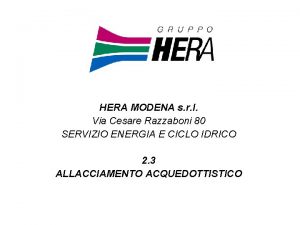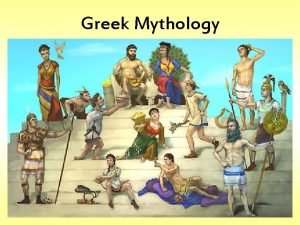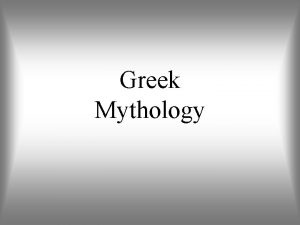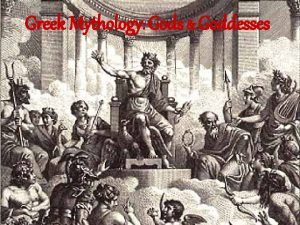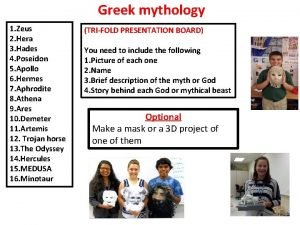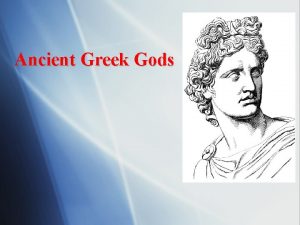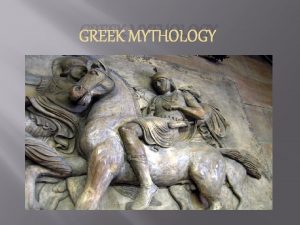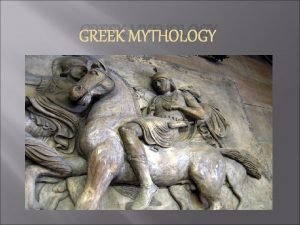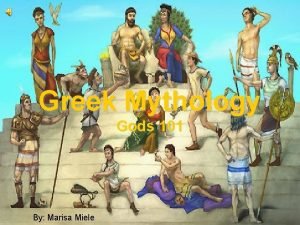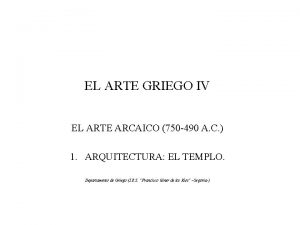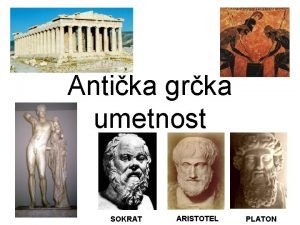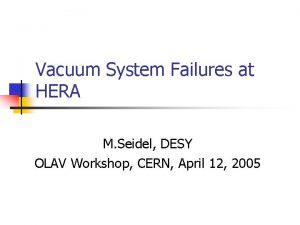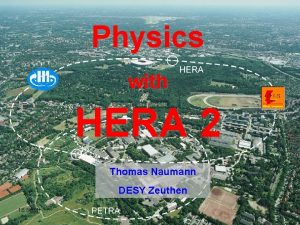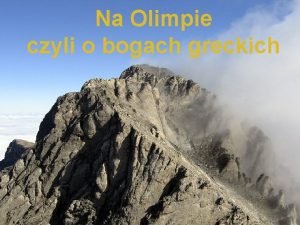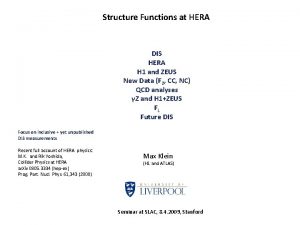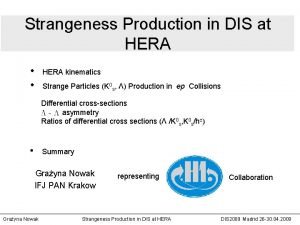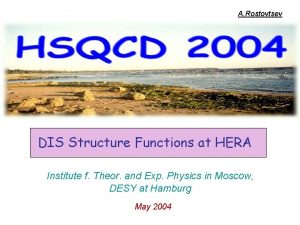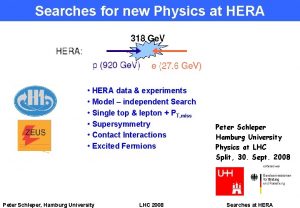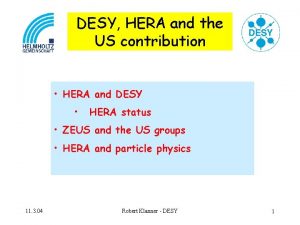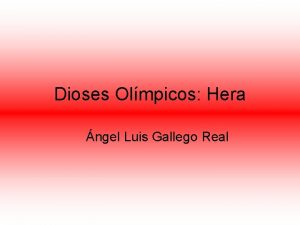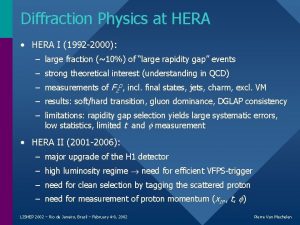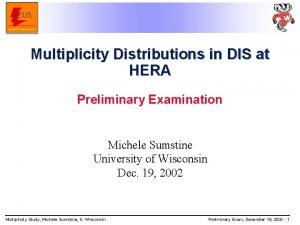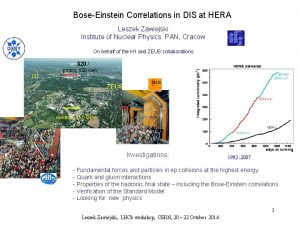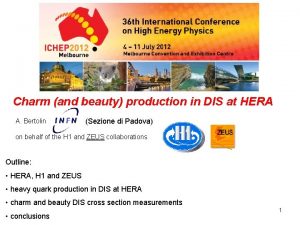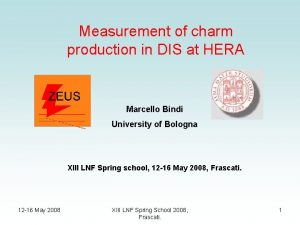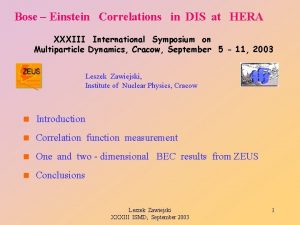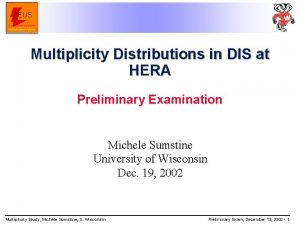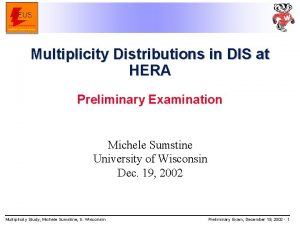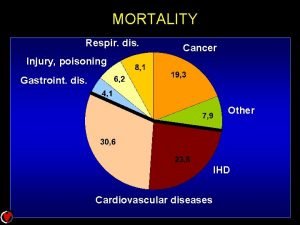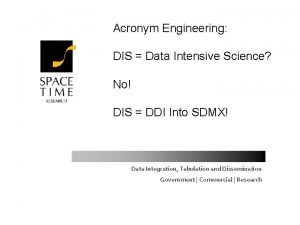Structure Functions at HERA DIS HERA H 1


























![The Fermi Scale [1985 -2010] pp b quark top quark MW Tevatron ep gluon The Fermi Scale [1985 -2010] pp b quark top quark MW Tevatron ep gluon](https://slidetodoc.com/presentation_image_h2/062b27506f9b61a8b58dc3c34305ef0e/image-27.jpg)



![The Te. V Scale [2010 -2035. . ] pp W, Z, top Higgs? ? The Te. V Scale [2010 -2035. . ] pp W, Z, top Higgs? ?](https://slidetodoc.com/presentation_image_h2/062b27506f9b61a8b58dc3c34305ef0e/image-31.jpg)


![The 10 -100 Ge. V Energy Scale [1968 -1986] (--) pp Drell Yan Charm The 10 -100 Ge. V Energy Scale [1968 -1986] (--) pp Drell Yan Charm](https://slidetodoc.com/presentation_image_h2/062b27506f9b61a8b58dc3c34305ef0e/image-34.jpg)
- Slides: 34

Structure Functions at HERA DIS HERA H 1 and ZEUS New Data (F 2, CC, NC) QCD analyses γZ and H 1+ZEUS FL Future DIS Focus on inclusive + yet unpublished DIS measurements Recent full account of HERA physics: M. K. and Rik Yoshida, Collider Physics at HERA ar. Xiv 0805. 3334 [hep-ex] Prog. Part. Nucl. Phys. 61, 343 (2008) Max Klein (H 1 and ATLAS) Seminar at SLAC, 8. 4. 2009, Stanford

Deep Inelastic e/μp Scattering

Neutral (NC) and Charged Current (CC) DIS Cross Sections Sensitive to sum or difference of q and anti-q Electroweak effects appear O(10 -4 Q 2/Ge. V 2). Charge and polarisation asymmetry effects. CC on protons are charge dependent Flavour separation but of sums of up and down quarks. Propto (1 ± Pe).

HERA: construction 1985 -1991 6. 2 km ring accelerator(s) Superconducting p: Ep =460 -920 Ge. V Warm e: Ee =27. 5 Ge. V, |Pe|=0. 3. . 0. 5 Data delivery (0. 6 fb-1): 1992 -2007 Seminar at Ulaan Baatar Max Klein March 16 th 2006

In 2001 the DESY directorate decided to rebuild PETRA as a 3 rd generation synchrotron light source considering the HERA programme to be exploited by 2006 and TESLA to be the next accelerator project of the laboratory.

H 1 A neutral current DIS event in the H 1 detector LAr (Pb –elm, SS –hadr) σhad =50%/√E Spa. Cal (elm+hadr) σelm =12%/√E B/C/FST CIP Driftchamber (CJC) … Trigger: LAr, CIP, FTT, BST Alignment (trackers, Comptons) Calibration (kinem. peak, DA) Luminosity: ep epγ (1%) MC simulation GEANT 3 + physics Redundant reconstruction of the kinematics from e and h(X) FS

ZEUS Uranium/Sc –elm and hadronic σelm =18%/√E, σhad =35%/√E MVD (fwd, central) Driftchamber (CTD) … Trigger: Calorimeter A charged current DIS event in the ZEUS detector Calibration and alignment methods and L measurement similar as for H 1. Kinematic reconstruction different, which is at the origin of the systematic error compensation in the combination of the H 1 and ZEUS cross section data.

F 2=νW 2 Most recent F 2 from 00 L=22 pb-1 H 1: e and Σ First F 2 data taken in 1992 L=0. 03 pb-1 H 1: e and h ZEUS: DA Most recent F 2, L from 07 14+7+44 pb-1 ZEUS: e

The lowest Q 2, x measurement of σr by H 1: DESY 08 -171 to appear Detailed account of methods. Lowest Q 2 accessed by shifting vertex, and using low edge of BDC + BST Reanalysis of 97 data, +3% (lumi) Novel combination method to combine different measurements (S. Glazov, DIS 05) based on χ2 minimisation with adjustment of systematic errors. 0. 2% energy scale uncertainty in kinematic peak (E’ = Ee), lower scales from π0, J/ψ and QED Compton events. Lowest Q 2 better covered by ZEUS BPT data.

The most precise F 2 measurement, H 1: DESY 09 -005 to appear Based on methods detailed in 08 -171, medium Q 2 accessed with maximum precision [1. 3 -2%] Reanalysis of 97 (820 Ge. V) data, +0. 5% (lumi) and small change of Q 2 dependence due to reweighting error. Both data sets combined to one. Electron scattered into Spa. Cal (“backwards”). Track with BDC cross checked with CJC and BST. 920 data taken in 2000, just before break for the luminosity upgrade of HERA. .

Low x - Violations of Bjorken Scaling DESY 09 -005 to appear

The new high Q 2 CC (e-p νX) measurement by ZEUS DESY 08 -177, submitted HERA II, 175 pb-1 CC depends linearly on P

The new high Q 2 NC (e-p e-X) measurement by ZEUS DESY 08 -202, submitted HERA II, 169 pb-1 polarised e- beam Double angle method:

QCD Fits of HERA Structure Function Data With NC and CC measure combinations of 4 parton distribution functions, U, anti-U, D and anti-D, where U=u+c, D=s+d. The valence quark distributions there follow, assuming that sea=anti-quarks ( is s = anti-s? ? ). Thus HERA NC and CC data alone allow a determination of a pdf set, free of HT, nuclear corrections and data inconsistencies, apart our own At an initial scale Q 02 the pdf’s are parameterised and h. o p. QCD evolution is used to obtain predictions for all x, Q 2 and y. A χ2 function is minimised allowing the data to move, constrained by penalty terms for error sources. Usually αs is fixed, but a dedicated fit of H 1+BCDMS was published in 01 and gave 0. 151 +- 0. 017 +- 0. 019. The pdf’s have an experimental uncertainty, a model uncertainty and nowadays a parameterisation uncertainty. The latter two are arbitrary to some extent. previous generation fits These fits can be compared with global data fits, by CTEQ, MRST/MSTW, Alekhin or the NNgroup. HERA has further data to allow consistency checks: F 2 charm, F 2 beauty, electroweak, FL

H 1: DESY 09 -005, to appear χ2 dof=587/644, The most recent NLO fit (H 1 PDF 2009) Q 02=1. 9 Sea at low x fixed by F 2 (if d=u!) Gluon at low Q 2, x uncertain, expressed via Q 02 variation; at high x too, expressed as parameterisation choice variation. Get astonishingly easy a high sea at large x. . “p is glue for x < 0. 1!” for Q 2 > few Ge. V 2 (DIS)

Combination of H 1 and ZEUS inclusive Data – x. F 3 Measurement of valence quarks [2 uv+dv]/3 down to low x, unless qsea ≠ anti-q Difficult to measure at HERA, needs high Q 2 and contributes only at high y as Y-=1 -(1 -y)2 Update of x. F 3 by ZEUS, DESY 08 -202 ICHEP 06, H 1 prel. 06 -142, ZEUSprel. 06 -022

Combination of H 1 and ZEUS inclusive Data – A± Q 2 =1. . 2 Ge. V 2 ICHEP 06, H 1 prel. 06 -142, ZEUSprel. 06 -022

Combination of H 1+ZEUS Data Minimisation for more than one data set with possible systematic error correlations among the sets (>100 sources in H 1/ZEUS). Being used for data combination and QCD fit (as in H 1 F 2 papers) Combinations: 06/07 high Q 2 mainly DIS 08: attempt for full systematic analysis including joint QCD fit to combined data. DIS 09: Madrid, end of April: new preliminary: adapt to modified χ2, include new H 1 data (see above which are 1. 3 -2% accurate in the bulk region). Fit close to H 1 pdf 09: VFNS, Q 02, parameterisation and uncertainties

Expectations on FL Experiment Theory (p. QCD) FL prediction related to the gluon density, the size and the uncertainties on xg constraints require max accuracy and range Theory developed to NNLO [W. van Neerven, J. Vermaseren, et al. ] A measurement of FL tests QCD at h. o. at low x Fixed target: FL is small at large x (spin 1/2 quarks) indications for increase towards low x H 1: hints to large FL when F 2 is assumed to be known Eur. Phys. J. C 21: 33 -61, 2001 MSTW 09 ar. Xiv 0901. 0002

FL - an experimental challenge Need to vary s, keep x, Q 2 fixed. Measure cross sections at high y Trigger on energy down to a few Ge. V Subtract photoproduction background to extract genuine DIS. Part of p events is tagged in downstream taggers. Important to measure charge of e candidate [done in H 1] Measure cross section as accurate as possible cannot measure FL at large x (low y) at HERA 2% at y=0. 7 gives ~0. 06 error on FL

Background Subtraction - H 1 At small energies DIS signal is superimposed by p events. Those are charge symmetric, apart from small effect due to anti-protons vs protons, which is measured using e+ and edata, and corrected for. H 1, in full range of Q 2 , has momentum measurement of e candidate. ESPa. Cal / p. CTD Scattered e energy distributions at medium and low Q 2 Spa. Cal and CJC (2008) Spacal + BST (2009 – today)

How to extract FL ? Separate structure functions at given x and Q 2 using straight line fit and error compensation. Intermediate energy for measurement control. Energy value chosen to interpolate in y 2/Y+ At low y, fixed x, Q 2 cross sections need to coincide: Renormalisation, used by H 1 and by ZEUS. Note ZEUS in a recent paper is using a joint fit to all data instead of the method sketched here.

The Longitudinal Structure Function FL - H 1 Ee’ > 3 Ge. V e. ID with max. p. T BST/CJC track and charge determination to remove γp bgd Values extracted point by point assuming uncorrelated errors at this stage. . Results at medium Q 2 are consistent with ZEUS but error treatment differs. At low x, Q 2 begin to obtain new constraint to p. QCD and models. BST Spa. Cal To be submitted to DIS 09 CJC Spa. Ca+LAr Improvement over first FL publication: F. D. Aaron et al. , Phys. Lett. B 665, 139 (2008 )

The Longitudinal Structure Function - ZEUS Ee’ > 6 Ge. V. e. ID with NN based on shower shape, some hit requirement (MVD, CTD) outside track reconstruction acc. Monte Carlo used for background subtraction DESY 09 -046, to appear Errors from joint fit allowing changes of systematics. Publish both FL and F 2 R=0. 18+0. 07 -0. 05 remember R=0. 18+-0. 10 from SLAC]

Measuring FL in e+p HERA Matched e and p beams: p beam wider Less focussing of e beam: better lifetime: went back to 60 o phase advance optics. New optics for both e and p beams. Kept magnet positions despite narrow apertures. Ep=460 Ge. V ~13 pb-1 575 Ge. V ~6 pb-1 Luminosity over 4 months at lower Ep End of 2 nd GM half quadrupole at ~-18 m /4 - Set up time of few days only - Luminosity prompt and as calculated - Polarisation increased (HERMES) -Time given for intermediate Ep run The culmination of HERA upgrade Specific luminosity over first 2 weeks

Summary The results on inclusive DIS from HERA have been most impressive, based on a reliable accelerator (team), efficient detectors for 15 years and genuine innovations in measurement techniques, often based on the redundancy from e and h kinematics determinations. In DIS at low x the proton is gluon dominated and the sea rises. p. QCD works over many orders of magnitude in x and Q 2 but the highest accuracy data may still shed a different light to x ≤ 10 -4. A full set of pdf’s has been determined and one is able to describe the heavy quark structure functions, and the Tevatron jet data to about 20% accuracy (not shown here) The HERA data thus represent a solid base for predicting Te. V scale pp interactions as is required for the initial phase of the LHC. More publications are imminent in 2009/10. These regard FL, combined HERA-I cross sections, HERA-II high Q 2 and high y, further QCD studies. .
![The Fermi Scale 1985 2010 pp b quark top quark MW Tevatron ep gluon The Fermi Scale [1985 -2010] pp b quark top quark MW Tevatron ep gluon](https://slidetodoc.com/presentation_image_h2/062b27506f9b61a8b58dc3c34305ef0e/image-27.jpg)
The Fermi Scale [1985 -2010] pp b quark top quark MW Tevatron ep gluon h. o. strong i. a. c, b distributions high parton densities HERA e+ e. The Standard Model Triumph MZ , sin 2 3 neutrinos h. o. el. weak (t, H? ) LEP/SLC CKM - B factories

Beyond HERA’s structure functions? Low x: the kinematic range is too small to establish the expected saturation of xg; there is no information on the flavour dependence of the sea Large x: the CC data are practically limited to x < 0. 5: The HERA based predictions at large x are rather uncertain (d/u? , xg? , sea-valence? ) The heavy quark distributions: not measured s, anti-s, just measured b, “no” Wb top Most of the pdf information is obtained using p. QCD fits, with serious deficiencies + ambiguities. The partonic contents of the proton is yet to be fully unfolded and QCD to be challenged. Understanding LHC observations, at high masses or related to xg, b (cf Higgs and SUSY Higgs), may require ep data in the appropriate kinematic range (see below for an example) The partonic structure of nuclei at lower x or higher Q 2 is a terra incognita beyond the fixed target range, yet we embark on quark-gluon plasma and CGC discoveries with ALICE (AA, p. A). We have missed to explore neutron’s structure in runs with deuterons (shadowing – diffraction, Gribov). Perhaps quarks have substructure below 10 -19 m, perhaps leptons and quarks are one type of matter. . We work on a CDR for the LHe. C by 2010 – Ring and LINAC (5 times 2 mile for 50 000 times SLAC’s Q 2) http: //www. lhec. org. uk

Structure Functions with the LHe. C high Lumi, high precision, new detector, full range: αs to 0. 0001 thy challenge CC e- T. Kluge, MK - DIS 08 High precision electroweak structure functions. Flavour separation to highest x CC e+ F 2 and FL: the ultimate challenge to saturation (Foreshaw et al, NNPDF group) MK. Divonne LHe. C workshop 9/2008 and DIS 07/08

pdf’s and New Physics at the LHC Factorisation is violated in production of high p. T particles (IS and FS i. a. s). E. Perez, Divonne NP may be accommodated by HERA/BCDMS DGLAP fit. It can not by the fit to also LHe. C. (recall high ET excess at the Tevatron which disappeared when xg became modified) Important, perhaps crucial, to measure pdf’s in the kinematic range of the LHC. cf also ED limits vs pdf’s.
![The Te V Scale 2010 2035 pp W Z top Higgs The Te. V Scale [2010 -2035. . ] pp W, Z, top Higgs? ?](https://slidetodoc.com/presentation_image_h2/062b27506f9b61a8b58dc3c34305ef0e/image-31.jpg)
The Te. V Scale [2010 -2035. . ] pp W, Z, top Higgs? ? New Particles? ? New Symmetries? LHC ep e+ e. New Physics* High Precision QCD High Density Matter Substructure? ? eq-Spectroscopy? ? ttbar Higgs? ? Spectroscopy? ? ILC/CLIC LHe. C * and the ‘completion’ of the old one

DIS has been most exciting for decades there can be a future to DIS, a tribute to Bjoern Wiik Willy van Neerven Pief Panofsky Wu-Ki Tung

Thank you cf recent DIS workshops and the one coming ar. Xiv – FL (ZEUS), F 2’s of H 1. . appearing the H 1 and ZEUS web pages and for LHe. C: http: //www. lhec. org. uk
![The 10 100 Ge V Energy Scale 1968 1986 pp Drell Yan Charm The 10 -100 Ge. V Energy Scale [1968 -1986] (--) pp Drell Yan Charm](https://slidetodoc.com/presentation_image_h2/062b27506f9b61a8b58dc3c34305ef0e/image-34.jpg)
The 10 -100 Ge. V Energy Scale [1968 -1986] (--) pp Drell Yan Charm W, Z Jets lh Quarks Neutral currents Singlet e. R Asymptotic Freedom e+ e. SU(2)L x U(1) QCD Charm 3 colours Gluon Jets
 Tpin sharekhan
Tpin sharekhan Athena roman name
Athena roman name Lesser roman gods
Lesser roman gods Hestia hades
Hestia hades Zeus weakness and strength
Zeus weakness and strength Ares characteristics
Ares characteristics Hermes roman name
Hermes roman name Hera oktadiana
Hera oktadiana Queen hera issue
Queen hera issue Hera campana
Hera campana Via razzaboni 80 modena
Via razzaboni 80 modena Apollo god
Apollo god Hera roman name
Hera roman name All about artemis
All about artemis Egyptian gods family tree
Egyptian gods family tree Interesting facts about athena
Interesting facts about athena Zeus roman name
Zeus roman name Artemisz jelképe
Artemisz jelképe Sąd parysa mit
Sąd parysa mit Hera
Hera God name
God name Hera roman name
Hera roman name Realm of hephaestus
Realm of hephaestus The wisest titan, who stole the sacred fire for the people.
The wisest titan, who stole the sacred fire for the people. Miele greece
Miele greece Templo de apolo en thermon
Templo de apolo en thermon Hera and zeus kids
Hera and zeus kids Poliklet
Poliklet Bogini domowego ogniska
Bogini domowego ogniska Vacuum system failure
Vacuum system failure Thomas hera
Thomas hera Hestia bogini czego
Hestia bogini czego D i e t, south-west, ghumman hera, new delhi-110073
D i e t, south-west, ghumman hera, new delhi-110073 What was apollos realm
What was apollos realm Considared
Considared
